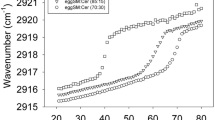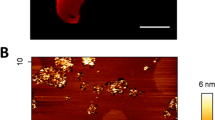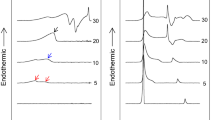Abstract
Long-chain saturated ceramides possess the ability to form gel domains in fluid bilayer membranes. Such domains may also contain sphingomyelin, but generally exclude cholesterol. We studied the effect of N-acyl chain methylations on the ability of ceramide to form ceramide- and sphingomyelin-containing gel domains that displace sterol. Fluorescence quenching of probes displaying different lateral partitioning in heterogeneous lipid bilayers showed that the methyl branches induced position-dependent changes in the lateral distribution of the ceramides. Distally monomethylated ceramides interacted with sphingomyelin and displaced sterol, whereas proximally monomethylated and polymethylated ceramides appeared to be located outside of sterol/sphingomyelin-enriched domains. The branched ceramides also markedly reduced the bilayer affinity for sterol as determined from the equilibrium partitioning of sterol between lipid vesicles and cyclodextrin. Altogether, alterations in intermolecular interactions induced by the methyl branches markedly affected the molecular properties of ceramide in artificial bilayers.



Similar content being viewed by others

Abbreviations
- (P)SM:
-
(Palmitoyl-)sphingomyelin
- PCer:
-
Palmitoyl-ceramide
- 10MeCer:
-
N-10-methyl-hexadecanoyl-ceramide
- 15MeCer:
-
N-15-methyl-heptadecanoyl-ceramide
- 16MeCer:
-
N-16-methyl-heptadecanoyl-ceramide
- PhytCer:
-
N-3,7,11,15-methyl-hexadecanoyl-ceramide
- tPA:
-
Trans-parinaric acid
- CTL:
-
Cholestatrienol
- CHL:
-
Cholesterol
References
Alanko SM, Halling KK, Maunula S, Slotte JP, Ramstedt B (2005) Displacement of sterols from sterol/sphingomyelin domains in fluid bilayer membranes by competing molecules. Biochim Biophys Acta 1715:111–121
Ben YV, Menashe M, Biltonen RL, Johnson ML, Barenholz Y (1987) Interaction of trans-parinaric acid with phosphatidylcholine bilayers: comparison with the effect of other fluorophores. Biochim Biophys Acta 904:117–124
Bittman R (1993) Chemical preparation of glycerolipids: a review of recent syntheses in Phospholipids Handbook. In: Cevec G (ed) Marcel Dekker, Inc., pp 154–155
Bjorkqvist YJ, Nyholm TK, Slotte JP, Ramstedt B (2005) Domain formation and stability in complex lipid bilayers as reported by cholestatrienol. Biophys J 88:4054–4063
Busto JV, Sot J, Requejo-Isidro J, Goni FM, Alonso A (2010) Cholesterol displaces palmitoylceramide from its tight packing with palmitoylsphingomyelin in the absence of a liquid-disordered phase. Biophys J 99:1119–1128
Castro BM, Silva LC, Fedorov A, de Almeida RF, Prieto M (2009) Cholesterol-rich fluid membranes solubilize ceramide domains: implications for the structure and dynamics of mammalian intracellular and plasma membranes. J Biol Chem 284:22978–22987
Cohen R, Barenholz Y, Gatt S, Dagan A (1984) Preparation and characterization of well defined D-erythro sphingomyelins. Chem Phys Lipids 35:371–384
Fischer RT, Stephenson FA, Shafiee A, Schroeder F (1984) delta 5, 7, 9(11)-Cholestatrien-3 beta-ol: a fluorescent cholesterol analogue. Chem Phys Lipids 36:1–14
Hannun YA, Luberto C (2000) Ceramide in the eukaryotic stress response. Trends Cell Biol 10:73–80
Jaikishan S, Bjorkbom A, Slotte JP (2010) Sphingomyelin analogs with branched N-acyl chains: the position of branching dramatically affects acyl chain order and sterol interactions in bilayer membranes. Biochim Biophys Acta 1798:1987–1994
Karlsson KA, Samuelsson BE (1974) The structure of ceramide aminoethylphosphonate from the sea anemone, Metridium senile. Biochim Biophys Acta 337:204–213
Lofgren H, Pascher I (1977) Molecular arrangements of sphingolipids. The monolayer behaviour of ceramides. Chem Phys Lipids 20:273–284
Massey JB (2001) Interaction of ceramides with phosphatidylcholine, sphingomyelin and sphingomyelin/cholesterol bilayers. Biochim Biophys Acta 1510:167–184
Maula T, Westerlund B, Slotte JP (2009) Differential ability of cholesterol-enriched and gel phase domains to resist benzyl alcohol-induced fluidization in multilamellar lipid vesicles. Biochim Biophys Acta 1788:2454–2461
Megha, London E (2004) Ceramide selectively displaces cholesterol from ordered lipid domains (rafts): implications for lipid raft structure and function. J Biol Chem 279:9997–10004
Megha, Sawatzki P, Kolter T, Bittman R, London E (2007) Effect of ceramide N-acyl chain and polar headgroup structure on the properties of ordered lipid domains (lipid rafts). Biochim Biophys Acta 1768:2205–2212
Nybond S, Bjorkqvist YJ, Ramstedt B, Slotte JP (2005) Acyl chain length affects ceramide action on sterol/sphingomyelin-rich domains. Biochim Biophys Acta 1718:61–66
Nyholm TK, Grandell PM, Westerlund B, Slotte JP (2010) Sterol affinity for bilayer membranes is affected by their ceramide content and the ceramide chain length. Biochim Biophys Acta 1798:1008–1013
Nystrom JH, Lonnfors M, Nyholm TK (2010) Transmembrane peptides influence the affinity of sterols for phospholipid bilayers. Biophys J 99:526–533
Oku H, Mimura K, Tokitsu Y, Onaga K, Iwasaki H, Chinen I (2000) Biased distribution of the branched-chain fatty acids in ceramides of vernix caseosa. Lipids 35:373–381
Perry DK, Hannun YA (1998) The role of ceramide in cell signaling. Biochim Biophys Acta 1436:233–243
Silva L, de Almeida RF, Fedorov A, Matos AP, Prieto M (2006) Ceramide-platform formation and -induced biophysical changes in a fluid phospholipid membrane. Mol Membr Biol 23:137–148
Sklar LA, Hudson BS, Simoni RD (1977) Conjugated polyene fatty acids as fluorescent probes: synthetic phospholipid membrane studies. Biochemistry 16:819–828
Sot J, Ibarguren M, Busto JV, Montes LR, Goni FM, Alonso A (2008) Cholesterol displacement by ceramide in sphingomyelin-containing liquid-ordered domains, and generation of gel regions in giant lipidic vesicles. FEBS Lett 582:3230–3236
Stancevic B, Kolesnick R (2010) Ceramide-rich platforms in transmembrane signaling. FEBS Lett 584:1728–1740
Tanaka II, Matsuoka S, Murata M, Tachibana K (1998) A new ceramide with a novel branched-chain fatty acid isolated from the epiphytic dinoflagellate coolia monotis. J Nat Prod 61:685–688
Tian XR, Tang HF, Li YS, Lin HW, Ma N, Zhang W, Yao MN (2009) Ceramides and cerebrosides from the marine bryozoan Bugula neritina inhabiting South China Sea. J Asian Nat Prod Res 11:1005–1012
Yano I, Imaizumi S, Tomiyasu I, Yabuuchi E (1983) Separation and analysis of free ceramides containing 2-hydroxy fatty acids in Sphingobacterium species. FEMS Microbiol Lett 20:449–453
Yasugi E, Kasama T, Seyama Y (1987) Branched long chain bases in cerebrosides of the guinea pig Harderian gland. J Biochem 102:1477–1482
Yasugi E, Kasama T, Seyama Y (1988) Identification of 10-methylsphinganine in cerebrosides of the guinea pig harderian gland. J Biochem 103:889–893
Yasugi E, Kasama T, Seyama Y (1991) Composition of long chain bases in ceramide of the guinea pig Harderian gland. J Biochem 110:202–206
Yu C, Alterman M, Dobrowsky RT (2005) Ceramide displaces cholesterol from lipid rafts and decreases the association of the cholesterol binding protein caveolin-1. J Lipid Res 46:1678–1691
Acknowledgments
We thank Thomas Nyholm for help with analyzing some of the data and Shishir Jaikishan for some assistance with the quenching experiments. Financial support from the Sigrid Juselius Foundation, Oskar Öflund Foundation, Medicinska Understödsföreningen Liv och Hälsa, National Doctoral Programme in Informational and Structural Biology, and Åbo Akademi University is gratefully acknowledged.
Author information
Authors and Affiliations
Corresponding author
Rights and permissions
About this article
Cite this article
Maula, T., Urzelai, B. & Peter Slotte, J. The effects of N-acyl chain methylations on ceramide molecular properties in bilayer membranes. Eur Biophys J 40, 857–863 (2011). https://doi.org/10.1007/s00249-011-0702-7
Received:
Revised:
Accepted:
Published:
Issue Date:
DOI: https://doi.org/10.1007/s00249-011-0702-7



